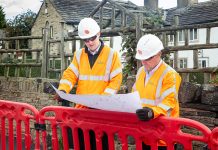A collaborative project between the University of Bath’s Water Research & Innovation Centre (WIRC) and Wessex Water is using high rate algal ponds to remove nutrients from waste water and creating an added value by-product. The £0.45M project is funded by UKWIR and forms part of their phosphorus removal trial programme.
Every day over 11 billion litres of wastewater is produced in the UK through domestic and industrial use. This wastewater must be cleaned, or treated, before it can be safely released back into the environment or risk causing serious harm to both human health and nature. As a chemical engineer, my work through the Water Research Innovation Centre at Bath is about researching better, more efficient methods for wastewater treatment. One area of this work involves a particular focus on how we might use natural and sustainable solutions for our wastewater challenges.
One of these challenges is of course finding solutions to reduce the levels of phosphorus from our water bodies, which, with pressure from the Water Framework Directive (WFD), has become an increasingly important area for both water utility companies, the Environment Agency, and the wider water stakeholder community. Many of our lakes, streams and rivers fail to meet the strict standards set for nutrients under the WFD and whilst our sewage treatment works (SWTs) are overall achieving high rates of nutrient remove, more needs to be done if we are to meet the challenging targets.
High levels of phosphorous in waterbodies upsets the natural balance of many plant and fish species. If levels become too high, eutrophication occurs leading to algal blooms and over-crowding, which in turn creates a downward spiral leading to a dramatic loss of plants and insects, and ultimately depleted oxygen levels which cause reduction or elimination of fish populations. The knock-on consequences for the whole food chain are therefore considerable. But what if the problem of algal blooms caused by high levels of phosphorus could in fact also be turned into the solution?
In the lead up to 2020 water companies across England will be trialling a range of new and different technologies aimed at finding a sustainable and effective solution for phosphorous removal, as an alternative to the traditional and increasingly expensive approach to ferric dosing. These technologies include the use of magnetite, and at least two different approaches to the use of algae. One of these is a project we’ve pioneered with Wessex Water – a installation involving high rate algae ponds (HRAPs) which we’ve installed at the SWT in Beckington in Somerset. These have been successfully used in other countries but to date not demonstrated in the UK. We’re keen to see what impact HRAPs might make in solving the phosphorous problem.
The principle behind HRAPs is a simple and satisfying one. In essence they are shallow ponds where the waste water being treated is continuously circulated by paddlewheels. Within each pond, algae harness sunlight to grow and draw nutrients from the waste water, they use carbon dioxide from a low rate gassing process. If algal growth is successfully maintained, very low levels of phosphorus (and nitrogen) are left on the water as the majority are locked up by the algal biomass. The water and algae mixture then transfer to a tank where gravity separated occurs. From this tank we get cleaner water which can be returned to the environment or reused, and nutrient rich algae biomass that can be used as biofuel or an agricultural fertiliser, or simply blended with digestate from other treatment works as a fertiliser supplement.
We believe using HRAPs has the potential to be both environmentally sustainable and economically attractive for companies and customers. From September 2016, we will be trialling this technology for 12-months at large pilot scale (up to 3.5 m3 day-1) to see how well this process functions across the different seasons when light levels and environmental conditions vary. The trial will provide valuable information as to whether HRAPs can be an effective new water treatment technology for use in the UK. Our very early results though are positive.
Through collaboration with Wessex Water and this pilot trial at Beckington we hope that we can demonstrate how a natural system like algae can be used to treat waste water on a small scale. We will be assessing treated water quality, the algal biomass which is produced, energy consumption, and capital expenditure. We will also explore options for further use or processing of the algal mass for value recovery. In parallel with this work we have a postgraduate student project funded by the EPSRC Centre for Doctoral Training in Water Informatics: Science and Engineering. He is working on metabolic modelling of algal metabolism, and directed evolution to improve algal performance in relation to phosphorus uptake, and to further refine the operating conditions in the HRAP systems. Together this information will provide the basis for a techno-economic evaluation of the potential for HRAP treatment to be deployed at larger-scale sites. Here the challenge will be in bringing down the cost of treatment to levels that are truly competitive with existing and established alternatives.







